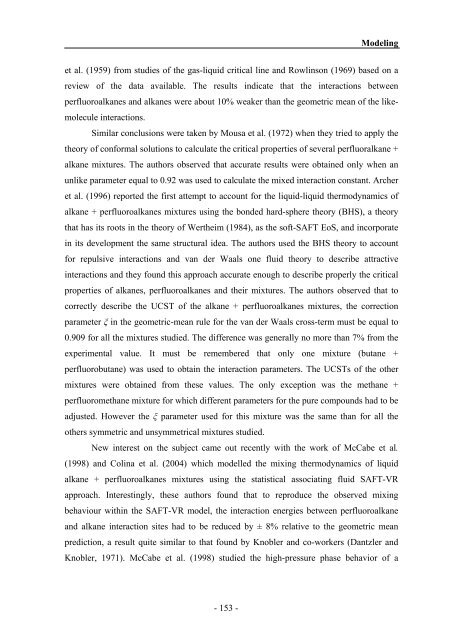n - PATh :.: Process and Product Applied Thermodynamics research ...
n - PATh :.: Process and Product Applied Thermodynamics research ...
n - PATh :.: Process and Product Applied Thermodynamics research ...
You also want an ePaper? Increase the reach of your titles
YUMPU automatically turns print PDFs into web optimized ePapers that Google loves.
Modeling<br />
et al. (1959) from studies of the gas-liquid critical line <strong>and</strong> Rowlinson (1969) based on a<br />
review of the data available. The results indicate that the interactions between<br />
perfluoroalkanes <strong>and</strong> alkanes were about 10% weaker than the geometric mean of the like-<br />
molecule interactions.<br />
Similar conclusions were taken by Mousa et al. (1972) when they tried to apply the<br />
theory of conformal solutions to calculate the critical properties of several perfluoralkane +<br />
alkane mixtures. The authors observed that accurate results were obtained only when an<br />
unlike parameter equal to 0.92 was used to calculate the mixed interaction constant. Archer<br />
et al. (1996) reported the first attempt to account for the liquid-liquid thermodynamics of<br />
alkane + perfluoroalkanes mixtures using the bonded hard-sphere theory (BHS), a theory<br />
that has its roots in the theory of Wertheim (1984), as the soft-SAFT EoS, <strong>and</strong> incorporate<br />
in its development the same structural idea. The authors used the BHS theory to account<br />
for repulsive interactions <strong>and</strong> van der Waals one fluid theory to describe attractive<br />
interactions <strong>and</strong> they found this approach accurate enough to describe properly the critical<br />
properties of alkanes, perfluoroalkanes <strong>and</strong> their mixtures. The authors observed that to<br />
correctly describe the UCST of the alkane + perfluoroalkanes mixtures, the correction<br />
parameter ξ in the geometric-mean rule for the van der Waals cross-term must be equal to<br />
0.909 for all the mixtures studied. The difference was generally no more than 7% from the<br />
experimental value. It must be remembered that only one mixture (butane +<br />
perfluorobutane) was used to obtain the interaction parameters. The UCSTs of the other<br />
mixtures were obtained from these values. The only exception was the methane +<br />
perfluoromethane mixture for which different parameters for the pure compounds had to be<br />
adjusted. However the ξ parameter used for this mixture was the same than for all the<br />
others symmetric <strong>and</strong> unsymmetrical mixtures studied.<br />
New interest on the subject came out recently with the work of McCabe et al.<br />
(1998) <strong>and</strong> Colina et al. (2004) which modelled the mixing thermodynamics of liquid<br />
alkane + perfluoroalkanes mixtures using the statistical associating fluid SAFT-VR<br />
approach. Interestingly, these authors found that to reproduce the observed mixing<br />
behaviour within the SAFT-VR model, the interaction energies between perfluoroalkane<br />
<strong>and</strong> alkane interaction sites had to be reduced by ± 8% relative to the geometric mean<br />
prediction, a result quite similar to that found by Knobler <strong>and</strong> co-workers (Dantzler <strong>and</strong><br />
Knobler, 1971). McCabe et al. (1998) studied the high-pressure phase behavior of a<br />
- 153 -



